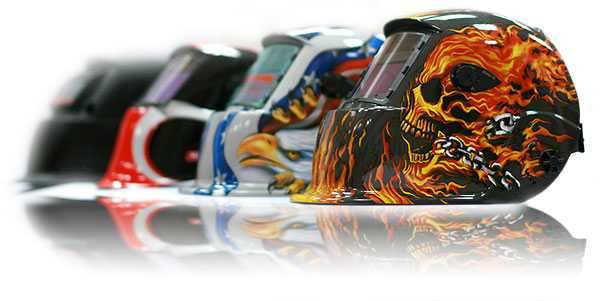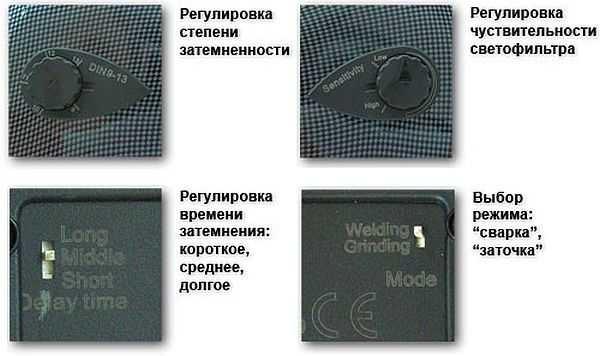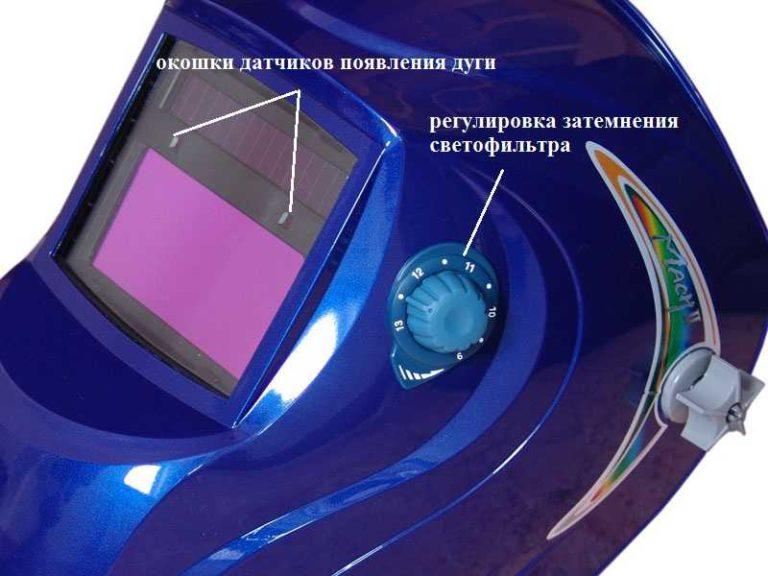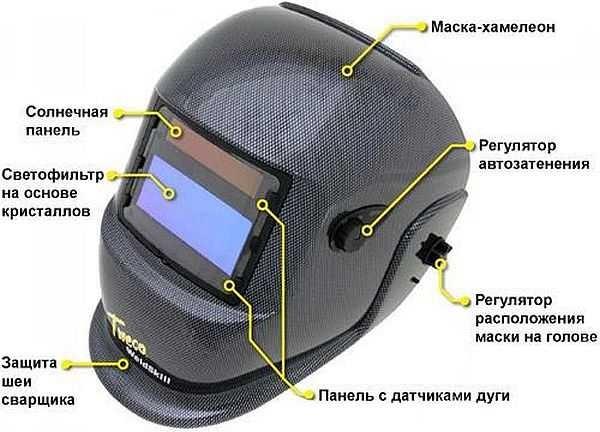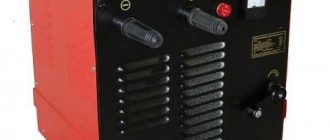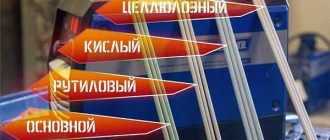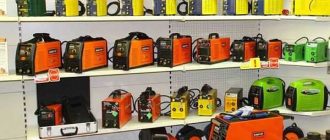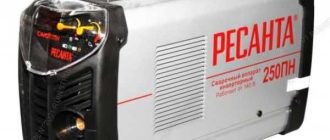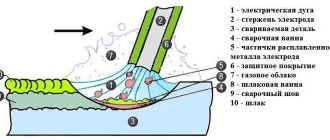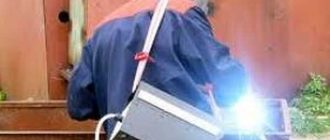Chameleon welding masks are so named because the light filter automatically changes the degree of dimming depending on the intensity of the light flux. This is much more convenient than a conventional shield or an older type of mask with a replaceable filter. But the vast selection of differently priced copies can put you in a deadlock: what is the difference and which one is better? How to choose a mask “chameleon”, we will tell you below.
Putting on a “chameleon” mask, you can see everything well even before welding: the filter is almost transparent and does not interfere with your work. When the arc is ignited, it darkens in a fraction of a second, protecting your eyes from burns. After the arc is extinguished, it becomes transparent again. You can perform all necessary manipulations without removing the mask, which is much more convenient than raising and lowering the shield, and certainly much better than holding the shield in your hand.
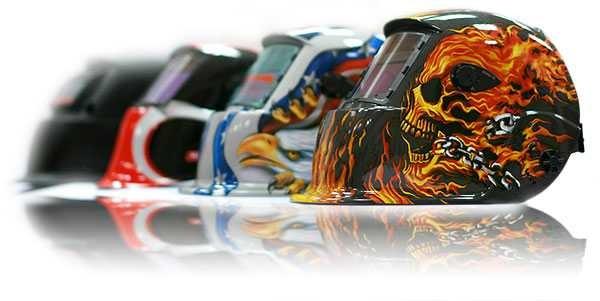
Raksta saturs
Light filter in the chameleon: what is it and what is better
That small glass, which is installed on the welding mask is a true miracle of science and technology. It contains the latest achievements in optics, microelectronics, in the field of liquid crystals and solar energy. That’s what “glass” is. In fact, it is a whole multi-layer pie, which consists of the following elements:
The main and main advantage of the welding mask-chameleon is that even if it has not had time to work, ultraviolet and infrared radiation it will not miss (if the mask was lowered). And the degree of protection from these harmful effects does not depend on the settings. In any case and at any settings you are protected from these types of harmful effects.
But this is only if there are appropriate filters in the “pie” and they are of proper quality. Since it is impossible to check this without special devices, we have to rely on certificates. And they masks must be mandatory. And on the territory of Russia can issue them only two centers: VNIIS and FGBU at the All-Russian Research Institute of Labor Protection and Economics. To be sure that the certificate is genuine, its number can be found on the official website of the federal service Rosakkredditatsiya here at this link.
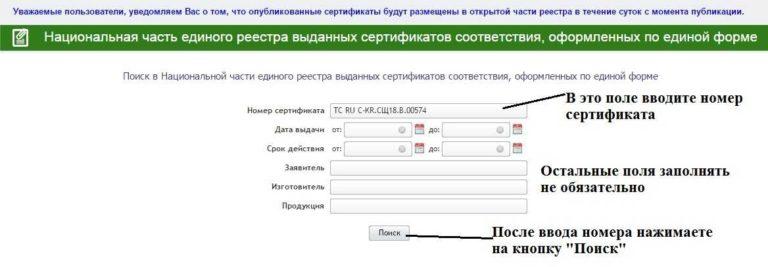
In the appropriate field enter the certificate number and get the date of validity, information about the applicant, manufacturer. A small note: the abbreviation PPEOD stands for “means of individual protection of optical action”. This is the name of the welder’s mask in bureaucratic language.

The most important thing is that you are convinced that this product (compare, by the way, and the name and model) is safe for your health.
Perhaps you will be interested in how to make a gazebo on a metal frame.
Classification of automatic welding light filters
Since the light filter and its quality is the key element in this product, then the choice of a chameleon mask should start with it. All its indicators are classified according to the EN379 standard and must be displayed on its surface through a fraction.
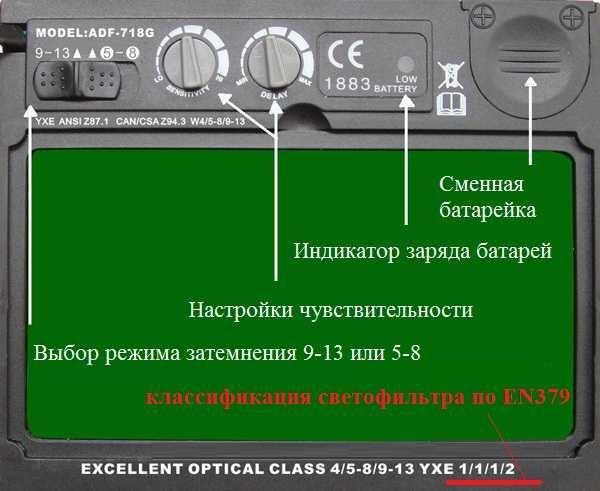
Now more details about what lies behind these numbers and what they should be. In each of the positions can stand a number from 1, 2, 3. Accordingly, “1” – the best option – the first class, “3” – the worst – the third class.Now about which position displays which characteristic and what it means.
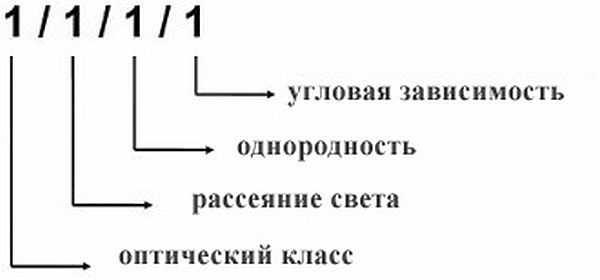
Optical class
It reflects how clearly and without distortion you will see the picture through the light filter. It depends on the quality of the protective glass (film) used and the quality of assembly. If the first place is “1”, distortion will be minimal. If the values are higher, you will see everything as through a crooked glass.
Light diffusion
Depends on the purity and quality of the optical crystals used. Indicates the degree of “turbidity” of the transmitted picture. It can be compared to a wet automobile glass: while there are no oncoming traffic, the drops do not interfere. As soon as a light source appears, everything becomes blurred. To avoid this effect, it is necessary to have a “1” on the second position.
Homogeneity or homogeneity
Indicates how evenly the filter is shaded in different parts. If the third position has a one, the difference can be no more than 0.1 DIN, 2 – 0.2 DIN, 3 – 0.3 DIN. It is clear that it will be more comfortable with uniform shading.
Angle dependence
Reflects the dependence of dimming on the viewing angle. Here, too, the best value is “1” – the first class changes the dimming by no more than 1 DIN, the second – by 2 DIN and the third – by 3DIN.
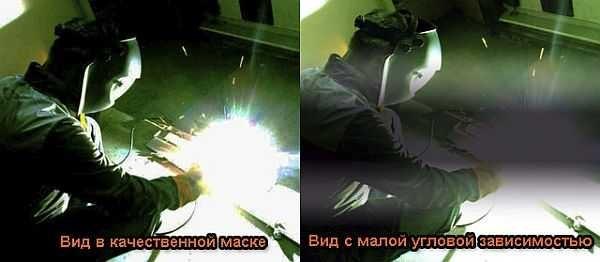
From all this it is clear that the more units in the characteristic of the light filter, the more comfortable you will work in the mask. This is what you should be guided by when choosing a welding mask chameleon. Professionals prefer at least these parameters 1/1/1/2. Such masks are expensive, but even with prolonged work in them do not tire the eyes.
Amateur welders, to work from time to time, you can get by with simpler light filters, but the 3rd class is considered “the last century”. That is why it is probably not worth buying masks with such filters.
And one more point. Sellers usually call all this classification by one term “Optical Class”. Simply this wording accurately reflects the essence of all the characteristics.
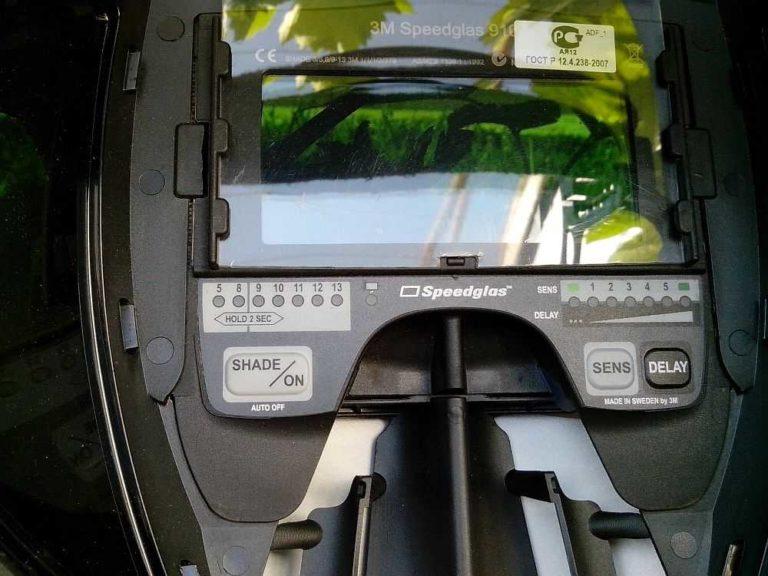
There are a few more chameleon settings that allow you to adjust the dimming mode for a given situation. They can be located inside, on the light filter, or they can be placed outside in the form of knobs on the left side of the mask. These are the following settings:
- Blackout Adjustment. Allows you to change the current dimming level. You can make it lighter/darker without taking your eyes off if the knob is on the outside. If it is on the inside, you will need to stop, remove the mask and twist the control. For non-professionals this is normal: they don’t need to work out. But the pros don’t always like external adjusters either: they can get caught on something.
The regulators themselves can be in the form of switches, wheels, can be made in the form of touch switches - Sensitivity adjustment. It is located inside the mask, on the filter. With its help you can set what the filter will trigger on: only on the arc, or also on bright light sources. If you work indoors, the sensitivity can be set high: the filter will darken when the arc occurs. Since there are no other variable light sources, it will not twitch. Outdoors at high sensitivity it may trigger on sun glare. So here you will have to reduce sensitivity.
- Delay of mask illumination. It is necessary for eyes not to receive a light shock from the hot metal after welding. If there is no delay, the filter becomes lighter at once and the bright glow of the weld pool hits your eyes. This is not dangerous or fatal, but it is unpleasant. The delay of dimming allows to “push back” for some time the moment of filter luminescence. Also this delay does not allow the filter to brighten if you are welding with arc breakage or with electrode sticking. So the adjustment is necessary.
You may be interested to read about the types of welds and joints, welding techniques and methods used.
Chameleon mask how to choose
In addition to the parameters of the light filter, there are a lot of other settings and features that can affect the choice.
- The number of arc detection sensors. They can be 2, 3 or 4. They react to the appearance of an arc. Visually, they can be seen on the front panel of the mask. These are small round or square “windows” on the surface of the filter. For amateur use is enough 2 pieces, for professionals – the more, the better: if some will be blocked (blocked by some object when welding in a difficult position), the rest will react.
Arc sensors are visible to the naked eye - Speed of light filter response. The range of parameters here is large – from tens to hundreds of microseconds. Choosing a mask for home welding, drill the one whose chameleon will darken no later than 100 microseconds. For professionals, the time is shorter: 50 microseconds. We sometimes don’t notice light strikes, but their result is tired eyes, and professionals need them all day long. So the requirements are tougher.
- Filter size. The larger the glass, the more visibility you get. But the size of the light filter is strongly reflected in the cost of the mask.
- Smooth or stepped adjustment of the degree of darkening. Smooth is better. If the filter will be darkened/clearer in leaps and bounds, you will get tired quickly. Besides, it may start “blinking” from glare, which will not please you.
- Initial degree of darkening and adjustment range. The lighter the filter in the initial state, the better you will see before welding. It is also desirable to have two dimming ranges: up to small degrees up to 8 DIN when working with argon or for manual arc welding in low light conditions. Also a smaller dimming may be needed for a person of age. For working with inverters at higher currents and in good light, dimming up to 13 DIN is needed. So it is better if there are two modes: 5-8DIN/8-13DIN.
- Power supply. On most welding masks with automatic dimming there are two types of power cells: solar panel and lithium batteries. This combined power source is the most reliable. However, the lithium battery compartment must be able to be opened to allow replacement of failed batteries. In some cheap masks batteries are integrated: they can be removed only by cutting the plastic (which sometimes our skillful people do).
One of the chameleon mask models. Here you can also see the mask position regulator on the head and the neck protection shield - Weight. Masks can weigh from 0.8 kg to 3 kg. If you have to wear a three-kilogram weight on your head for seven or eight hours, by the end of the shift your neck and head will be as wooden. For amateur welding this parameter is not very critical, although it is not comfortable to work in a heavy mask.
- Convenience of fastening on the head. There are two systems of fastening the headband and the shield itself, but for these masks they are almost unimportant: you do not need to raise/lower the mask every time. It can be lowered throughout the job. What matters is how many adjustments there are and how tightly they allow you to fit the headband. It is also important that all these straps do not press, do not rub, so that the welder is comfortable.
- Having an adjustment that allows you to move the face shield away from your face. This is important if you need glasses for normal vision. Then the shield needs to be moved farther away from your face to fit your lenses.
Of the useful but optional modes, there is also the ability to switch the mac from welding mode to grinding mode. With this switch, you actually turn off the power to the light filter, your mask becomes a regular face shield.
About choosing a welding machine for home or dacha, read here. And to try out the purchased mask can be used in the manufacture of a metal brazier.
Brands and manufacturers
How to choose a chameleon mask for welding you know, but how to navigate among the mass of manufacturers? In reality, everything is not very difficult. There are proven brands that deliver always quality products and confirm their warranty obligations. Here they are not very many:
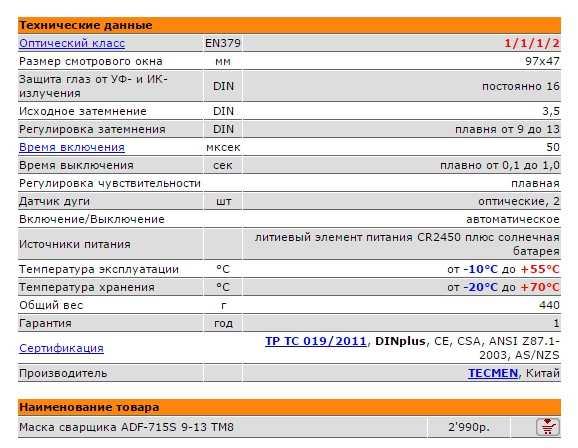
- SPEEDGLAS from Sweden;
- OPTREL from Switzerland;
- BALDER from Slovenia;
- OTOS from South Korea;
- TECMEN from China (don’t be surprised, the masks are really good).
It is not easy to choose a chameleon mask for home use. On the one hand, you need it to be of high quality, but to pay 15-20 thousand for it is clearly not everyone can afford, and it is not profitable. Therefore, we have to forget about European manufacturers. They at least produce good masks, but their prices are not less than 70$.
On the market there are many Chinese masks of very low cost. But it is risky to buy them. If you need a proven Chinese brand, it is TECMEN (Tekmen). They have really certified chameleon masks of factory quality. The model range is quite wide, prices – from 3 thousand rubles to 13 thousand rubles. There are with light filters of the first class (1/1/1/2) and a little worse, with all settings and adjustments. After the upgrade, even the cheapest mask for 3000 rubles (TECMEN DF-715S 9-13 TM8) has a replaceable battery, delay of enlightenment from 0.1 to 1 sec, smooth adjustment and mode of operation “grinding”. The photo below shows its specifications. It’s hard to believe, but it costs only 2990 rubles.
Not badly reviewed by owners about welding masks Resanta. There are not many models, but MS-1, MS-2 and MS-3 are not a bad choice for a small amount of money (from 2 thousand rubles to 3 thousand rubles).

Resanta masks MS-1 and MS-3 have a smooth adjustment, which is undoubtedly more convenient. But in the chameleon MS-1 there is no sensitivity adjustment. Professionals are unlikely to satisfy them, but for home use they are quite suitable.
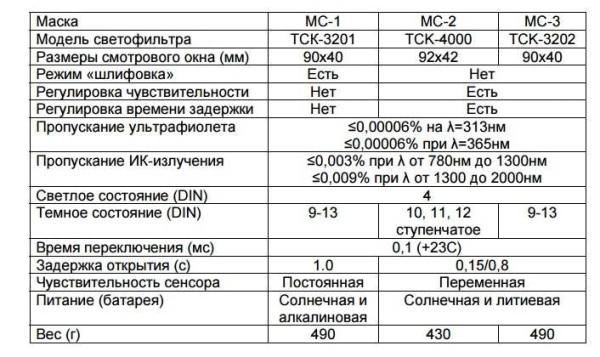
Very good masks are produced by the South Korean company OTOS (Otos). Its prices are slightly higher than those listed above, but there are two relatively inexpensive models: OTOS MACH II (W-21VW) for 8700 rubles and ACE-W i45gw (Infotrack™) for 13690 rubles.
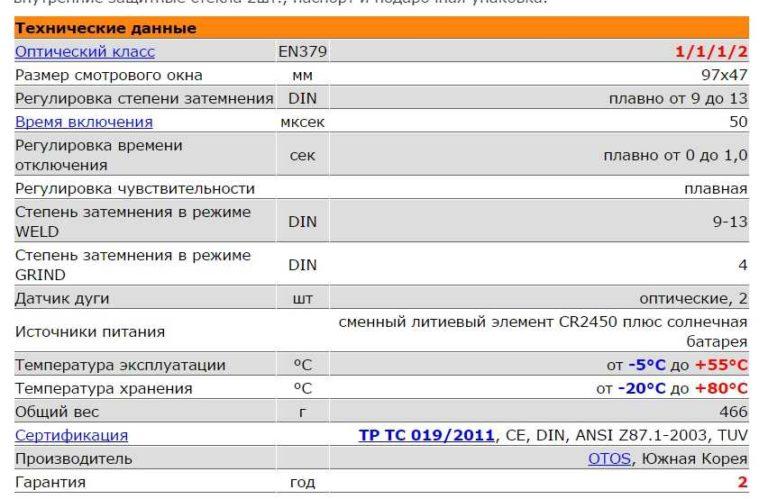
Read here about how to choose electrodes for inverter welding.
Operation of the welding chameleon mask
The main requirement to care for the mask: the light filter must be taken care of, it is easily scratched. Therefore, the mask should not be placed face down. It should be wiped only with absolutely clean and soft cloth. If necessary, you can moisten the cloth with clean water. Do not wipe with alcohol or any solvents: the light filter is covered with a protective film, which dissolves in these liquids.
There is one more peculiarity of any welding chameleons: they start to “slow down” at low temperatures. That is, they operate with a delay, and in both directions – both for darkening and brightening. This feature is very unpleasant, so you can’t work normally in them in winter, even if the operating temperature is specified from -10 °C, as on TECMEN DF-715S 9-13 TM8. Already at -5 °C all can’t darken in time. So OTOS was more honest in this respect, having specified a starting operating temperature of -5 °C.
Finally, watch the video on how to choose a chameleon mask for welding.

